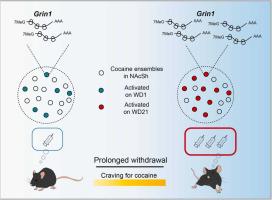当前位置:
X-MOL 学术
›
Prog. Neurobiol.
›
论文详情
Our official English website, www.x-mol.net, welcomes your feedback! (Note: you will need to create a separate account there.)
Accumulation of NMDA receptors in accumbal neuronal ensembles mediates increased conditioned place preference for cocaine after prolonged withdrawal
Progress in Neurobiology ( IF 6.7 ) Pub Date : 2024-02-22 , DOI: 10.1016/j.pneurobio.2024.102573 Ziqing Huai , Bing Huang , Guanhong He , Haibo Li , Yonghui Liu , Qiumin Le , Feifei Wang , Lan Ma , Xing Liu
Progress in Neurobiology ( IF 6.7 ) Pub Date : 2024-02-22 , DOI: 10.1016/j.pneurobio.2024.102573 Ziqing Huai , Bing Huang , Guanhong He , Haibo Li , Yonghui Liu , Qiumin Le , Feifei Wang , Lan Ma , Xing Liu

|
Cue-induced cocaine craving gradually intensifies following abstinence, a phenomenon known as the incubation of drug craving. Neuronal ensembles activated by initial cocaine use, are critically involved in this process. However, the mechanisms by which neuronal changes occurring in the ensembles after withdrawal contribute to incubation remain largely unknown. Here we labeled neuronal ensembles in the shell of nucleus accumbens (NAcSh) activated by cocaine conditioned place preference (CPP) training. NAcSh ensembles showed an increasing activity induced by CPP test after 21-day withdrawal. Inhibiting synaptic transmission of NAcSh ensembles suppressed the preference for cocaine paired-side after 21-day withdrawal, demonstrating a critical role of NAcSh ensembles in increased preference for cocaine. The density of dendritic spines in dopamine D1 receptor expressing ensembles was increased after 21-day withdrawal. Moreover, the expression of , a subunit of the N-methyl-D-aspartate (NMDA) receptor, specifically increased in the NAcSh ensembles after cocaine withdrawal in both CPP and self-administration (SA) mouse models. Targeted knockdown or dysfunction of in NAcSh ensembles significantly suppressed craving for cocaine. Our results suggest that the accumulation of NMDA receptors in NAcSh ensembles mediates increased craving for cocaine after prolonged withdrawal, thereby providing potential molecular targets for treatment of drug addiction.
中文翻译:

长期戒断后,累积神经元群中 NMDA 受体的积累介导可卡因条件性位置偏好的增加
戒断后,由提示引起的可卡因渴望逐渐加剧,这种现象被称为药物渴望的潜伏期。最初使用可卡因激活的神经元群在这一过程中发挥着重要作用。然而,退出后神经元变化导致孵化的机制仍然很大程度上未知。在这里,我们标记了由可卡因条件位置偏好(CPP)训练激活的伏隔核(NAcSh)外壳中的神经元集合。停药 21 天后,CPP 测试诱导 NAcSh 整体活性增加。在戒断 21 天后,抑制 NAcSh 整体的突触传递抑制了对可卡因配对侧的偏好,这表明 NAcSh 整体在增加对可卡因的偏好中发挥着关键作用。停药 21 天后,表达多巴胺 D1 受体的树突棘密度增加。此外,在 CPP 和自我给药 (SA) 小鼠模型中,在可卡因戒断后,N-甲基-D-天冬氨酸 (NMDA) 受体亚基的表达在 NAcSh 整体中特异性增加。 NAcSh 整体的靶向敲低或功能障碍显着抑制了对可卡因的渴望。我们的研究结果表明,NAcSh 整体中 NMDA 受体的积累会介导长期戒断后对可卡因的渴望增加,从而为药物成瘾的治疗提供潜在的分子靶点。
更新日期:2024-02-22
中文翻译:

长期戒断后,累积神经元群中 NMDA 受体的积累介导可卡因条件性位置偏好的增加
戒断后,由提示引起的可卡因渴望逐渐加剧,这种现象被称为药物渴望的潜伏期。最初使用可卡因激活的神经元群在这一过程中发挥着重要作用。然而,退出后神经元变化导致孵化的机制仍然很大程度上未知。在这里,我们标记了由可卡因条件位置偏好(CPP)训练激活的伏隔核(NAcSh)外壳中的神经元集合。停药 21 天后,CPP 测试诱导 NAcSh 整体活性增加。在戒断 21 天后,抑制 NAcSh 整体的突触传递抑制了对可卡因配对侧的偏好,这表明 NAcSh 整体在增加对可卡因的偏好中发挥着关键作用。停药 21 天后,表达多巴胺 D1 受体的树突棘密度增加。此外,在 CPP 和自我给药 (SA) 小鼠模型中,在可卡因戒断后,N-甲基-D-天冬氨酸 (NMDA) 受体亚基的表达在 NAcSh 整体中特异性增加。 NAcSh 整体的靶向敲低或功能障碍显着抑制了对可卡因的渴望。我们的研究结果表明,NAcSh 整体中 NMDA 受体的积累会介导长期戒断后对可卡因的渴望增加,从而为药物成瘾的治疗提供潜在的分子靶点。



























 京公网安备 11010802027423号
京公网安备 11010802027423号